- Free Teaching Resources
- Universities
- Public Colleges
- Private Colleges
- N6 Question Papers and Memorandums with Study Guides
- N5 Question Papers and Memorandums with Study Guides
- N4 Question Papers and Memorandums with Study Guides
- N3 Question Papers and Memorandums with Study Guides
- N2 Question Papers and Memorandums with Study Guides
- N1 Question Papers and Memorandums with Study Guides
- Latest Updates
- Learning Content


Sewage Spills is the Biggest Threat We are Facing in South Africa: An Argumentative Essay Guide
Sewage Spills is the Biggest Threat We are Facing in South Africa: An Argumentative Essay Guide :
The issue of sewage spills in South Africa has become a topic of growing concern in recent years, as the country continues to grapple with the negative consequences of these occurrences on public health, the environment, and the economy. T his article aims to provide a comprehensive guide for students who are tasked with writing an argumentative essay on this critical subject matter. By examining the root causes, the impact on various sectors, and the proposed solutions to address this crisis, students will be well-equipped to develop a robust and thought-provoking argument. Engaging in such discourse is crucial for fostering awareness, facilitating informed debates, and ultimately driving meaningful change in South Africa’s approach to sewage management.
Table of Contents
Sewage Spills in South Africa is a Serious Issue
Sewage spills in South Africa pose a significant threat to the environment, as they lead to the pollution of rivers, lakes, and other water sources, which in turn disrupts ecosystems and destroys habitats. A prime example of this is the ongoing contamination of the Vaal River, South Africa’s second-largest river, which has been severely polluted by sewage spills from the Emfuleni Local Municipality. The deterioration of water quality has resulted in massive fish kills, the loss of aquatic biodiversity, and the spread of invasive species such as the water hyacinth. Consequently, the contamination has had a ripple effect on the environment, disrupting the balance of ecosystems and threatening the survival of various species that depend on these water sources.
The public health risks associated with sewage spills in South Africa are another major cause for concern. The release of untreated sewage into water sources can lead to the spread of waterborne diseases such as cholera, dysentery, and typhoid fever, particularly in communities that rely on these sources for drinking, bathing, and other daily activities. For instance, the Sebokeng sewage spill in 2018 contaminated nearby water sources and posed serious health risks to local residents, who were exposed to harmful pathogens and bacteria present in the sewage. In such cases, communities often experience outbreaks of waterborne diseases, putting immense pressure on the already strained healthcare system in the country.
The economic costs associated with sewage spills cannot be overlooked. South Africa’s tourism industry, which contributes significantly to the national economy, can suffer greatly from the negative publicity associated with contaminated water sources and polluted environments. For example, the ongoing sewage spills in the Vaal River have discouraged recreational activities such as fishing, boating, and bird-watching, leading to the decline of tourism revenue in the area. Additionally, sewage spills can impact the agricultural sector, as polluted water used for irrigation can contaminate crops, rendering them unfit for consumption or sale. This not only affects the livelihoods of farmers but also contributes to food insecurity in the affected regions.
Sewage Spills in South Africa: An Argumentative Essay Guide
Introduction
- Briefly introduce the topic of sewage spills in South Africa
- State the purpose of the essay: to present an argumentative essay on the causes, consequences, and possible solutions to sewage spills in South Africa
- Provide a roadmap of the main points that will be discussed in the essay
Causes of Sewage Spills
- Aging Infrastructure: Discuss how aging and poorly maintained infrastructure contributes to sewage spills (e.g., the 2018 Sebokeng sewage spill)
- Urbanization and Population Growth: Describe how rapid urbanization and population growth have put pressure on existing sewage systems (e.g., the expansion of informal settlements)
- Insufficient Funding and Resources: Explain how a lack of funding and resources has hindered the maintenance and improvement of sewage infrastructure
Consequences of Sewage Spills
- Environmental Impacts: Discuss the impacts of sewage spills on the environment, such as pollution of rivers and ecosystems (e.g., the contamination of the Vaal River)
- Public Health Risks: Explain how sewage spills can lead to waterborne diseases and other health risks for local populations (e.g., cholera outbreaks)
- Economic Costs: Describe the economic costs associated with sewage spills, including tourism and agricultural losses (e.g., the loss of recreational opportunities along the Vaal River)
Relevant Acts and Regulations
- National Water Act (1998): Explain the key provisions of the act and how they relate to sewage spills
- The Water Services Act (1997): Describe the responsibilities of local authorities and the national government in providing water services and managing wastewater
- National Environmental Management Act (1998): Discuss the environmental principles and pollution control measures outlined in the act
Examples of Sewage Spills in South Africa
- Sebokeng Sewage Spill (2018): Describe the spill, its causes, and consequences for the local community and environment
- Vaal River Contamination (ongoing): Discuss the ongoing contamination of the Vaal River due to sewage spills, and the consequences for the surrounding communities and ecosystems
- Durban Sewage Spill (2019): Explain the circumstances surrounding the spill and its impacts on the environment and public health
Proposed Solutions
- Infrastructure Upgrades: Argue for the need to invest in upgrading and maintaining sewage infrastructure to prevent future spills
- Environmental Education and Awareness: Advocate for increased education and awareness campaigns to inform the public about the consequences of sewage spills and the importance of proper waste disposal
- Strengthening Regulations and Enforcement: Make a case for stronger regulations and enforcement of existing laws to hold polluters accountable and prevent sewage spills
- Summarize the main points of the essay
- Emphasize the urgency of addressing sewage spills in South Africa to protect the environment, public health, and the economy
- End with a call to action for stakeholders to take immediate steps to address the issue
In conclusion, this article has provided students with a thorough guide for crafting an argumentative essay on sewage spills in South Africa. By exploring the complex factors that contribute to this issue, students are better positioned to understand the gravity of the situation and the urgent need for intervention. As South Africa works towards a sustainable future, it is essential for young scholars to engage with pressing topics such as this and contribute to the discourse by articulating well-informed, evidence-based arguments. Through academic endeavors and public engagement, the next generation can play a vital role in addressing the challenges posed by sewage spills, safeguarding the environment, and ultimately improving the quality of life for all South Africans.
Did You See These?
Radiography studies High School Requirements in SA
ACT Cape Town Courses and Programmes 2024/2025 (Prospectus)
Discussing Why Unequal Access to Basic Services Could Give Rise to Social Injustices
Guide: Writing a Conclusion for an Essay on “Why the Bantu Education Act Is Interesting or Important to Know About Today”
Why I Admire Nelson Mandela Essay Guide and Example
How can the Notion of Ubuntu be Incorporated in Classroom Practice
All Conveyancing Exam Question Papers and Memorandums: South Africa
UKZN Masters Application Guide
- Share This Post:
Reset Password
Sewage leaks put South Africa’s freshwater at risk: how citizen scientists are helping clean up
Research Associate, Centre for Water Resources Research, School of Agricultural, Earth and Environmental Sciences, University of KwaZulu-Natal
Aquatic Ecologist, Centre for Water Resources Research, School of Agricultural, Earth and Environmental Sciences, University of KwaZulu-Natal
Contributor
Doctoral student FitzPatrick Institute of African Ornithology, University of Cape Town
Disclosure statement
Jim Taylor has received funding from The Water Research Commission (WRC). He is affiliated with the Wildlife and Environment Society of South Africa (WESSA).
Mark Graham works for GroundTruth and GroundTruth have received research funding to investigate the role of Citizen Science and EnviroChamps in improved water resource management - from the WRC, CGIAR and UNICEF - for this this work. Mark is also a Director of DUCT
Nicholas B. Pattinson works for GroundTruth. He receives funding from UNICEF and the CGIAR-IWMI.
University of Kwa-Zulu Natal provides funding as a partner of The Conversation AFRICA.
View all partners
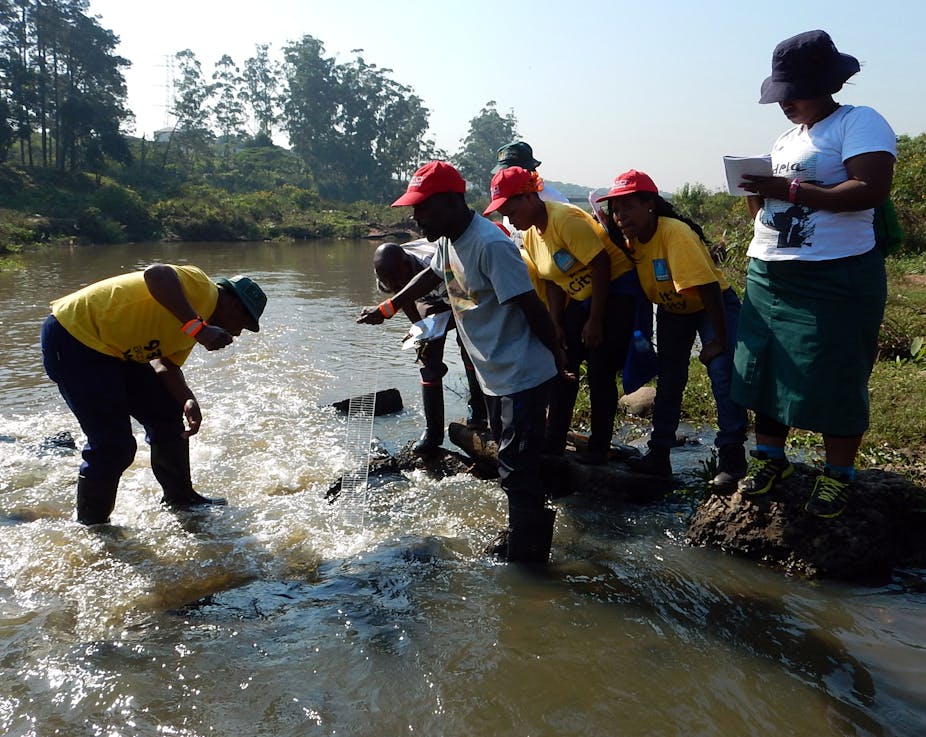
Across South Africa, sewage systems are leaking and contaminating the country’s freshwater. Involving the affected communities can help prevent this pollution hazard, as a group of 15 citizen scientists in KwaZulu-Natal province have shown. Their community water monitoring programme, working with municipal authorities, has managed to prevent raw sewage from flooding into rivers.
The young, unemployed residents from Mpophomeni, a working-class area, became “Enviro-Champs” in 2009 through a partnership initiated by the non-profit Duzi uMngeni Conservation Trust and the Mgungundlovu District Municipality. By 2021, similar intiatives had started up in other parts of South Africa .

Working together with community members, we carried out research to scientifically approach the ongoing work and concept of the Enviro-Champs. We found they could use a customised app on their smartphones to report data about environmental hazards, such as sewage spills, to their managers in real time. This would then be reported to local authorities.
Freshwater is growing scarcer and more polluted in South Africa. Our research with the Enviro-Champs demonstrated that there was potential for citizen scientists using apps to do similar work across rural South Africa. Community awareness and mobilisation is needed if freshwater is to be better monitored and managed.
The problem
The quality of South Africa’s freshwater has deteriorated, becoming increasingly obvious in the last decade. This is because of poorly treated or untreated wastewater or sewage that flows into dams and rivers. The Department of Water and Sanitation’s annual Green Drop reports document this serious situation, showing last year that 576 sewage works, or 66% of the 876 that were assessed, were failing and at risk of becoming completely dysfunctional.
Contaminated freshwater leads to tragedies such as the cholera outbreak in South Africa’s Hammanskraal region in 2023 , when at least 40 people died from contaminated water sources. Cholera is associated with contaminated food and water and usually relates to poor water, sanitation and hygiene practices.
Read more: Cholera in South Africa: a symptom of two decades of continued sewage pollution and neglect
South Africa’s freshwater is also polluted by nutrient loading. This is where water and waste rich in nutrients ends up in rivers, streams and dams. Nutrient pollution comes mainly from poorly functioning sewage treatment works, runoff from fertilised farm land, and waste from cattle feedlots and chicken houses. When it runs into rivers and dams, it can lead to the growth of toxic blue-green algae blooms (cyanobacteria). This can cause tumours and cancer . Cyanobacteria have degraded the Hartebeestpoort dam (in South Africa’s North West province) to the level that its water is largely unsafe for recreational use or even animal consumption.
In KwaZulu-Natal, the uMsunduzi River which flows through Pietermaritzburg shows increasingly high Escherichia coli ( E. coli ) counts , a sign of severe sewage pollution. E.coli can cause cramps, severe diarrhoea and even kidney failure . It is safe to predict that over time, South Africa will suffer large-scale ecological, financial and human disasters if the freshwater crisis is not solved urgently.
Citizen scientists to the rescue
The Enviro-Champs citizen scientists joined a Duzi-uMngeni Conservation Trust project that was set up to respond to the problem of raw sewage that flowed from 104 leaking manholes in Mpophomeni into streams and then into the nearby Midmar Dam. This dam is the main water source for 4.3 million people in the cities of Pietermaritzburg and South Africa’s third largest economic hub, Durban.

The Enviro-Champs became the eyes and ears of the community and were able to take action to solve problems. They checked water quality, reported issues and, at times, repaired freshwater leaks. They also monitored and removed litter and solid waste that had been dumped. The Enviro-Champs also became skilled at identifying and removing invasive alien plants.
They used citizen science tools such as clarity tubes to measure water clarity. The water clarity is then used to estimate the total suspended solid content of the water, a useful way to check the water quality.
Enviro-Champs also visited people at home in the community to share knowledge about waste, hygiene and sanitation issues. Their primary role was to let the local authorities know about sewage spills so that leaking pipes could be repaired before rivers were contaminated. Years of neglect in many parts of South Africa mean that these spills and leaks are largely ignored .
Through the network’s efforts, the 104 manholes that the Enviro-Champs had been monitoring stopped leaking sewage by 2016.
The solutions
The Enviro-Champs research found that they could send more comprehensive information to their managers if they had a customised mobile app to help capture data on sewage leaks and other issues. There are similar water quality monitoring apps in use globally. The best kind of app for the Enviro-Champs would be one with the capacity to upload photos, videos and GPS co-ordinates to a database. This information would also be shared with the group’s managers and potentially the local authorities in real time.

The app has now been developed and is in use, although there is little funding for maintenance, including upgrades and customisation, which costs a monthly fee. Mobile data is also a serious concern, especially in poorer rural areas where any extra expenses the Enviro-Champs incur can deter them from participating.
Through the efforts of the Duzi-uMngeni Conservation Trust, the South African National Biodiversity Institute , uMngeni-uThukela Water , Unicef-YOMA (the Youth Agency Marketplace) , CGIAR , the International Water Management Institute and GroundTruth , the project has recently been upscaled. There are now 1,000 Enviro-Champs across KwaZulu-Natal, funded by the Presidential Employment Stimulus and Social Employment Fund .
Why it matters
Water contamination events that cause serious illness will become more common without drastic and urgent action to improve monitoring, conservation, treatment and management of South Africa’s freshwater resources. The story of the Enviro-Champs shows how communities practising citizen science can become better informed and lead important changes in society.
Nicholas B. Pattinson contributed to the research for this article .
- Citizen science
- Science and innovation for development

Lecturer / Senior Lecturer - Marketing

Communications and Engagement Officer, Corporate Finance Property and Sustainability

Assistant Editor - 1 year cadetship

Executive Dean, Faculty of Health

Lecturer/Senior Lecturer, Earth System Science (School of Science)

Argumentative Essay About Sewage Spill
The repercussions of sewage spills are far-reaching, affecting both the environment and human well-being. This essay delves into the detrimental effects of sewage spills and presents a compelling argument for enhanced preventive measures to mitigate their devastating impacts.
Table of Contents
Essay: Sewage Spills – Unveiling Environmental Threats and Advocating Prevention
Unveiling the Negative Impacts of Sewage Spills: Sewage spills, often caused by inadequate infrastructure, natural disasters, or human neglect, give rise to multifaceted challenges. They pose a grave threat to human health, aquatic ecosystems, and the environment as a whole. These spills harbor a cocktail of harmful pathogens that can inflict severe illnesses upon human populations, particularly those who are more susceptible due to age or weakened immune systems.
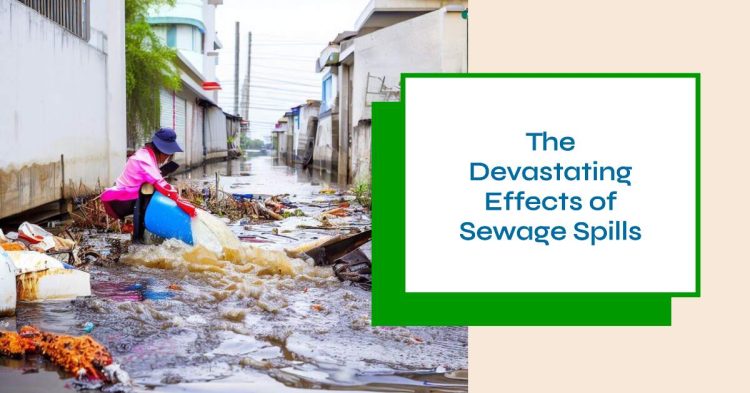
Environmental Degradation
The Ripple Effect: The effects of sewage spills extend beyond human health, permeating aquatic ecosystems. The influx of nutrients from sewage can lead to the proliferation of algal blooms, which deplete oxygen levels in water bodies, endangering aquatic life. The far-reaching consequences of these spills encompass contaminating drinking water sources, jeopardizing the well-being of entire communities.

Economic Implications of Neglect
Beyond environmental harm, sewage spills also carry significant economic repercussions. The costs of spill clean-up, ecosystem remediation, and lost revenue for businesses can be staggering. Moreover, the adverse impact on public health amplifies healthcare costs and impairs workforce productivity. Sewage spills, thus, strike at the very heart of economic vitality.
Advocating for Prevention
1. Upgrading Infrastructure
Investing in the enhancement of sewage infrastructure is paramount in curbing spills. Overhauling aging sewer systems and augmenting wastewater treatment plant capacities can thwart overflows during rainfall and alleviate the risks associated with spills.
2. Promoting Public Awareness
A strategic educational campaign targeting the proper disposal of waste and the risks of flushing non-biodegradable items down the toilet can significantly curtail the entry of pollutants into the sewer system.
3. Enforcement of Regulations
The enforcement of stringent regulations on waste disposal by businesses and industries is an essential deterrent against potential spills. This regulatory vigilance ensures accountability and prevents future transgressions.
Preserving Environmental and Human Health
The urgency of addressing sewage spills transcends the environmental domain, reaching the core of societal well-being. The collective responsibility to prevent spills necessitates a multi-pronged approach that spans infrastructure development, public engagement, and stringent regulatory frameworks. As stewards of our environment, it is our moral imperative to champion these measures and usher in a future where sewage spills are a rarity, not a norm.
Sewage spills cast a long shadow, encompassing health hazards, ecological disruption, and economic setbacks. The imperative to prevent such spills is undeniable, as their consequences reverberate across various dimensions of society. By bolstering infrastructure, raising public awareness, and enforcing regulations, we can alleviate the burdens imposed by sewage spills. In this concerted effort, we carve a path toward a cleaner environment, enhanced public health, and a sustainable future for generations to come.

Hello! Welcome to my Blog StudyParagraphs.co. My name is Angelina. I am a college professor. I love reading writing for kids students. This blog is full with valuable knowledge for all class students. Thank you for reading my articles.
Related Posts:
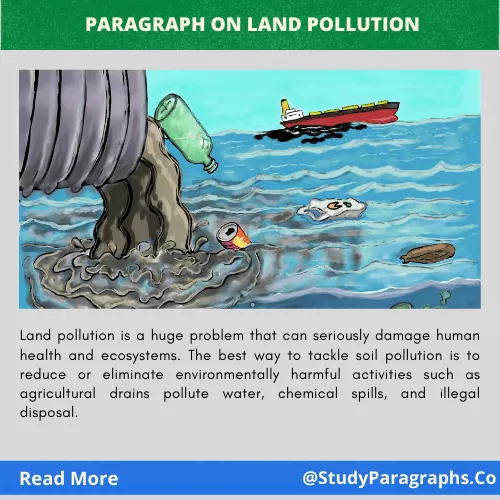
Leave a Reply Cancel reply
Your email address will not be published. Required fields are marked *
Save my name, email, and website in this browser for the next time I comment.
Accept cookies?
We use cook ies to give you the best online experience and to show personalised content and marketing. We use them to improve our website and content as well as to tailor our digital advertising on third-party platforms. You can change your preferences at any time.
Popular search terms:
- British wildlife
- Wildlife Photographer of the Year
- Explore the Museum
- Anthropocene
British Wildlife
Collections
Human evolution
What on Earth?
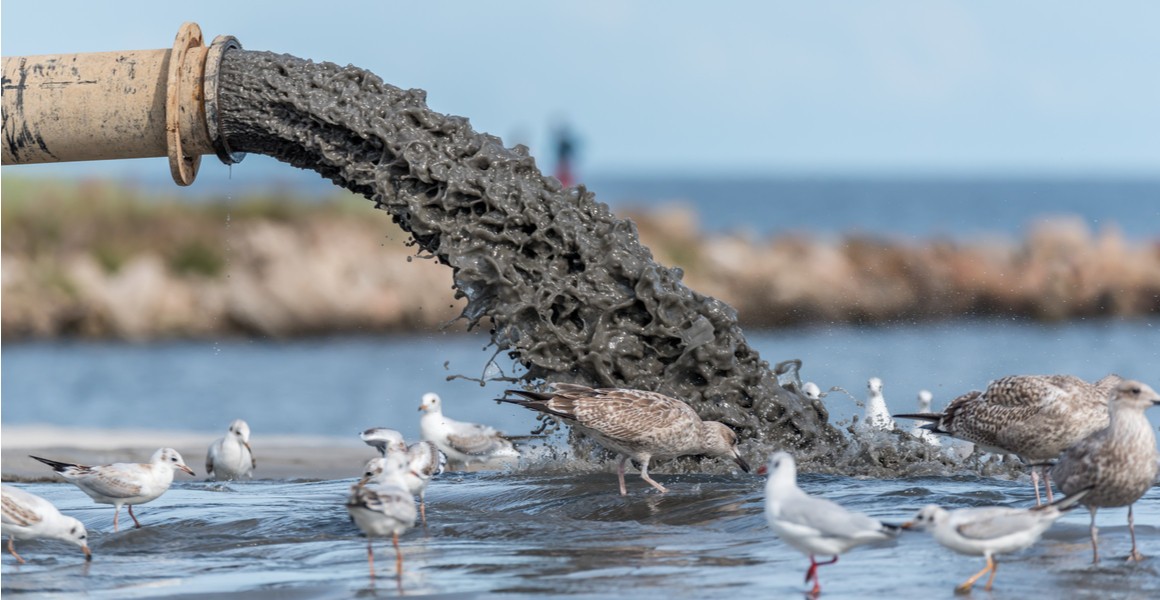
The UK Government has announced a duty for water companies to reduce sewage discharge following a backlash. Image © Shutterstock / JonShore
During Beta testing articles may only be saved for seven days.
Create a list of articles to read later. You will be able to access your list from any article in Discover.
You don't have any saved articles.
The deadly effects of sewage pollution on nature
Sewage in Britain's waterways has been hitting the headlines recently. But what effect does raw waste have on our rivers, streams and oceans?
Recent weeks have witnessed a public outcry after the House of Commons declined to force water companies to take all reasonable steps to ensure untreated sewage is not discharged into the UK's rivers.
The Government had argued that the amendment would have cost taxpayers hundreds of billions of pounds, although it later agreed to introduce changes to the law following a high-profile campaign.
Sewage is a danger to human health, but it also has a huge impact on the animals and plants living in waterways.
For instance, algal blooms are encouraged by the presence of sewage and can lead to the deaths of many other species.
Dr Anne Jungblut , Principal Researcher in algae, fungi and plants at the Museum, says algal blooms are 'a big problem.'
'Blooms can lead to a change in biodiversity,' she says, 'and can impact the functioning and richness of an ecosystem. Algae has a huge impact on an ecosystem and big blooms can change the whole river.'
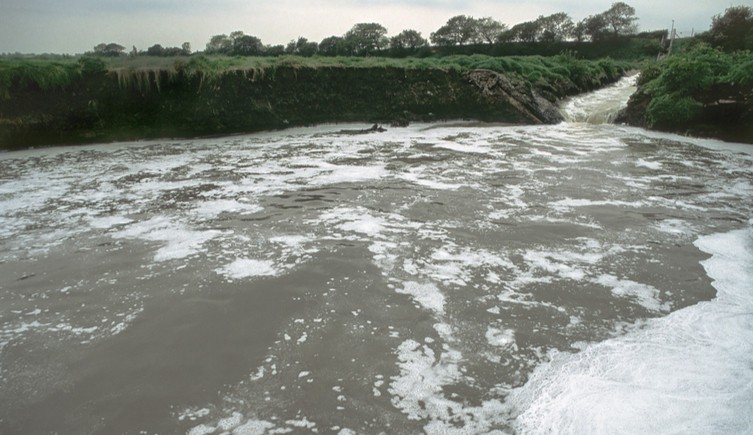
Sewage may be released into waterways if there are no chemicals available to treat it. Image © Shutterstock / Silent Corners
The politics
To prevent sewers becoming overwhelmed, water companies are allowed to release sewage into rivers in emergencies. This generally occurs in times of heavy rain to prevent the sewers backing up into buildings.
In 2020, sewage was released into the UK's waterways on over 400,000 occasions , with wastewater overflow from utility firms lasting for over 3.1 million hours.
On average, each storm overflow the companies operate is in use for 11 days a year, rising to almost 20 for Thames Water.
These figures only encompass the events water companies have self-reported, with firms having broken the law in recent years. For instance, Southern Water was fined £90 million after admitting thousands of illegal discharges between 2010 and 2015.
While some releases may be partially treated, those from storm overflows are raw and diluted only by rainwater. As a result, these overflows can contain anything that goes down the drain, from human waste to household chemicals and plastics.
Following the impact on the UK's supply chains from Brexit and the Coronavirus pandemic, the Government has also enabled companies to discharge sewage at any time if there are a lack of chemicals to treat it.
While the highest risk wastewater may not be released, medium and low risk substances may be discharged provided the use of chemicals is resumed 'as soon as is practicable.'
In recent weeks, concerns over these practices have spilled into the mainstream. Beyond simply being unpleasant, the wastewater can cause serious damage to fragile river ecosystems.

Algal blooms form as a result of an abundance of nutrients. Image © Shutterstock / Kit Leong
Algal blooms
Releasing sewage into rivers introduces a large amount of nutrients into the water. This process, known as eutrophication, can have serious consequences.
Anne explains, 'When sewage is released into rivers, it contains a lot of nitrogen and phosphorous. These can stimulate the growth of algae, such as phytoplankton in the water or mats known as biofilms in the sediments, which can lead to algal blooms.
'A large amount of algae has an impact on the rest of the ecosystem, such as blocking out the light that plants need for photosynthesis. When these plants, and the algae itself, start to die, they are eaten by a lot of bacteria which reduces oxygen in the water, killing fish and other organisms.'
One of the groups which is most badly affected by a lack of oxygen are freshwater insects , many of which spend large periods of their development in rivers.
Steve Brooks , who researches insects at the Museum, says, 'Insects are like a canary in a coal mine, providing an early warning system that something isn't right.
'Most aquatic invertebrates in a river depend on high oxygen levels because most don't have the option to swim to the surface as they'll be swept away. When this oxygen disappears because of sewage, then the species disappear too.
'The most affected insects are stoneflies and mayflies as they don't survive well without high oxygen. In turn, this can have a knock-on impact on fish . While fish can swim away from an area of sewage contamination, they can't escape if their prey has disappeared.'
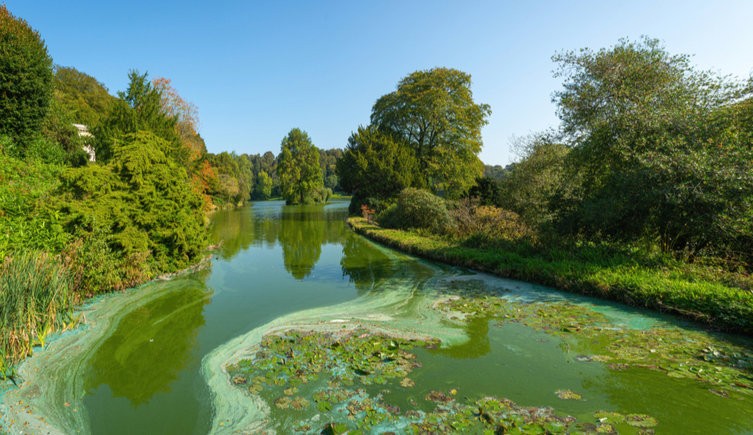
Blue green algae produces a range of toxins that can prove fatal to wildlife. Image © Shutterstock / Stefan-Kadar
While algal blooms may harm some species, they provide a boon for others to grow at their expense.
For instance, insects like midges have haemoglobin, the oxygen-carrying compound found in red blood cells. This allows them to tolerate low oxygen conditions, leading to an explosion in their populations. The same is also true of some algal groups, which are more prone to bloom than others.
'Eutrophication will lead to a shift of the composition of the algae,' Anne says. 'Some diatom species do really well and form blooms as they are particularly good at taking up lots of nutrients and growing really fast. This can then lead to a reduction of the river's overall biodiversity.'
The conditions of the river affect which groups prosper. Slower moving rivers, or those which have become blocked, can promote the growth of toxic algae which prefer these conditions.
'Stagnant water can lead to the formation of blue green cyanobacteria blooms,' Anne says. 'As well as contributing to eutrophication, they also produce toxins that are toxic not only to fish, but also to any humans or dogs that drink the water.
'While I haven't seen any records that have specifically been linked to a sewage release in the UK, releasing large amounts of nutrients into stagnant waterways raises the probability of these kinds of blooms occurring.'
These toxic organisms come in addition to compounds already in treated wastewater, which can include heavy metals , microplastics and chemicals such as pesticides.
Some of these chemicals have been found to cause physiological changes in fish. Treated wastewater can cause male brown roaches to develop ovarian cavities , as well as induce changes in the kidneys and immune system.
Fish may also be drawn towards wastewater, especially in winter, as wastewater outflows can increase the temperature of the water by up to 9⁰C. However, contaminants are also at their highest at this time, with researchers describing these outflows as an 'ecological trap'.
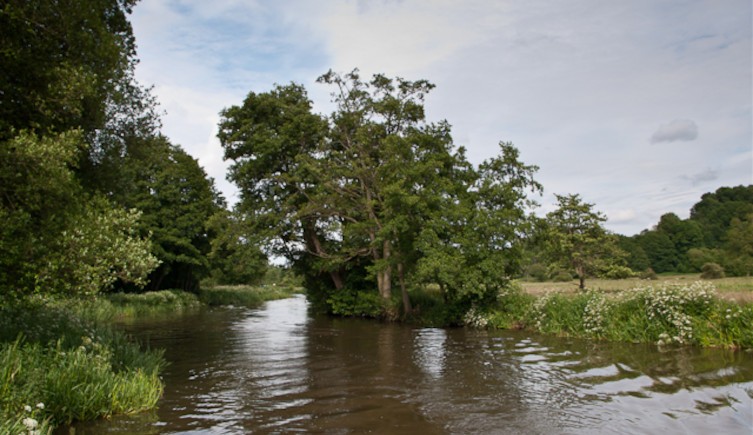
Mayflies were wiped out in the River Way in 2014. Image © Ian Capper, licensed under CC BY-SA 2.0 via Geograph .
Restoring rivers
Once sewage has been released into a river, there is little that can be done to prevent its impact. However, the ecosystems can recover if they are not overwhelmed.
'The possibility of recovery depends on the nature of the spillage,' says Steve. 'An acute spill comes and goes, so while it might remove a lot of insects from the river, the recovery can be quicker. For instance, many freshwater insects tend to fly up the river as adults to lay their eggs, which are then washed back down. This allows recolonisation of the river to take place.
'However, chronic pollution causes real problems as there is no possibility for recovery. In 2014, the River Wey in Surrey was polluted and the mayflies were wiped out.
'There wasn't a natural recovery, as there was no opportunity to come back from the pollution.'
While the responsibility of treating sewage lies with utility companies, everyone can play their part in improving water quality. The River Wey was restored thanks to a project led by Dr Cyril Bennett , who reintroduced mayflies by moving juveniles from other rivers.
He is also involved in the Riverfly Partnership , a group which monitors the water quality of rivers to protect the habitat of a range of flies.
Steve, who is helps to co-ordinate the partnership, says, 'We train volunteers to monitor biodiversity at a range of sites by taking a standardised sample from a river and giving scores to different groups of insects.
'If the score falls below a certain trigger level then there is an issue so the Environment Agency gets contacted to look into it. Over the years, volunteers have detected dozens of incidents than can then be pinpointed to a specific site.'
Anyone spotting rivers containing algal blooms should keep themselves away from the water, and report it to the Environment Agency directly or through apps such as Bloomin' Algae . Though the bloom may not be toxic, it is always safest to assume it is.
- Biodiversity
- Find out what else Anne is working on here.
- Find out what else Steve is working on here.

Do your bit for nature
Small actions can make a big difference.
Here's how you can help protect biodiversity.

Protecting our planet
We're working towards a future where both people and the planet thrive.
Hear from scientists studying human impact and change in the natural world.
The time is now
Related posts.
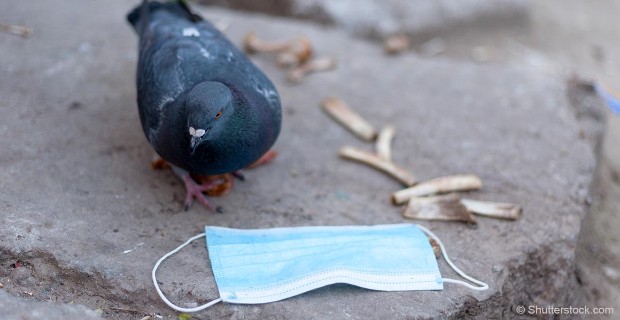
Will coronavirus cripple the fight against plastic pollution?
Single-use plastics have seen a resurgence in 2020.
Don't miss a thing
Receive email updates about our news, science, exhibitions, events, products, services and fundraising activities. We may occasionally include third-party content from our corporate partners and other museums. We will not share your personal details with these third parties. You must be over the age of 13. Privacy notice .
Follow us on social media
How Sewage Pollution Ends Up In Rivers
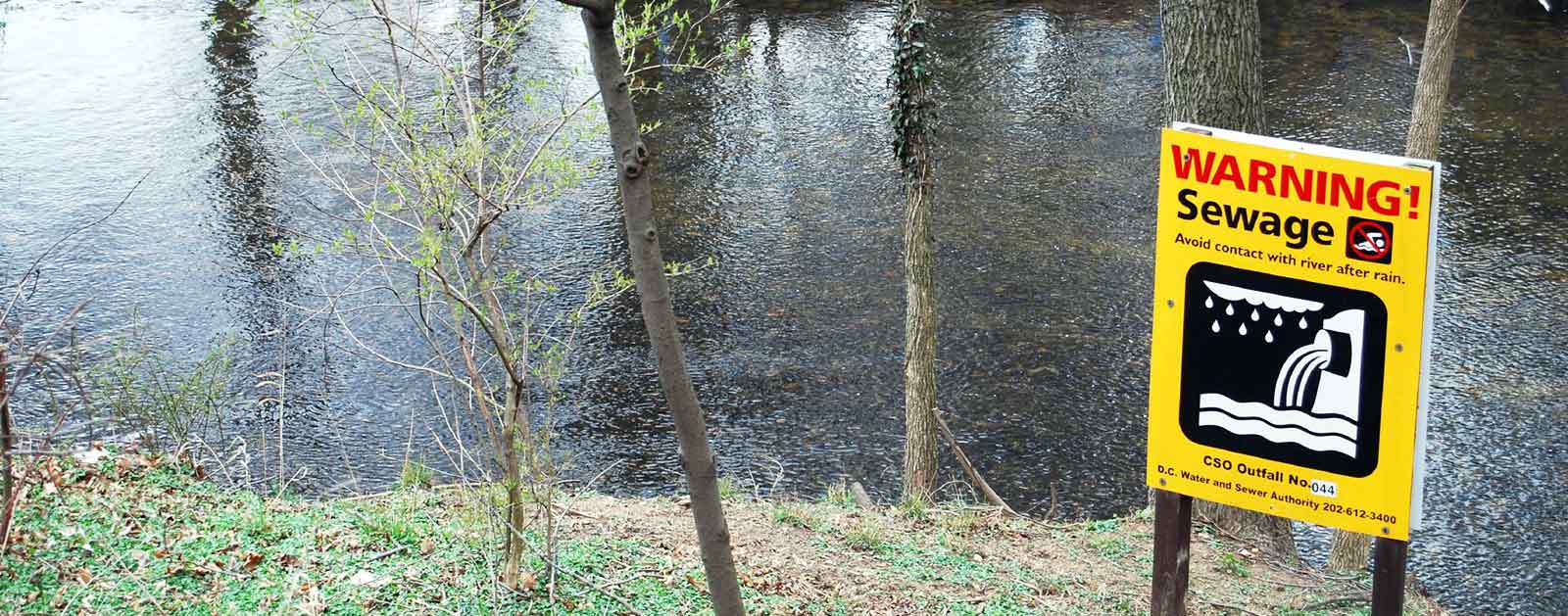
3.5 MILLION AMERICANS GET SICK EACH YEAR AFTER SWIMMING, BOATING, FISHING, OR OTHERWISE TOUCHING WATER THEY THOUGHT WAS SAFE.
Where does human waste mingle with household chemicals, personal hygiene products, pharmaceuticals, and everything else that goes down the drains in American homes and businesses?
And what can you get when rain, pesticides, fertilizers, automotive chemicals, and trash run off the streets and down the gutters into those very same sewers? Sewage backing up into people’s basements. Sewage spilling onto streets and parks. Sewage pouring into rivers and streams.
Each year, more than 860 billion gallons of this vile brew escapes sewer systems across the country. That’s enough to flood all of Pennsylvania ankle-deep. It’s enough for every American to take one bath each week for an entire year.
After bursting out of a pipe or manhole cover, this foul slurry pollutes the nearest body of water. Downstream, some of it may be pumped out, treated, and piped into more homes and businesses. From there, it goes back into a sewer system, and the cycle resumes.
A threat to human health
Untreated human sewage teems with salmonella, hepatitis, dysentery, cryptosporidium, and many other infectious diseases.
One hundred years ago, epidemics of these diseases helped limit the life expectancy of a U.S. citizen to about 50 years. Estimates vary for how many people sewage still sickens or kills each year, but they are all large.
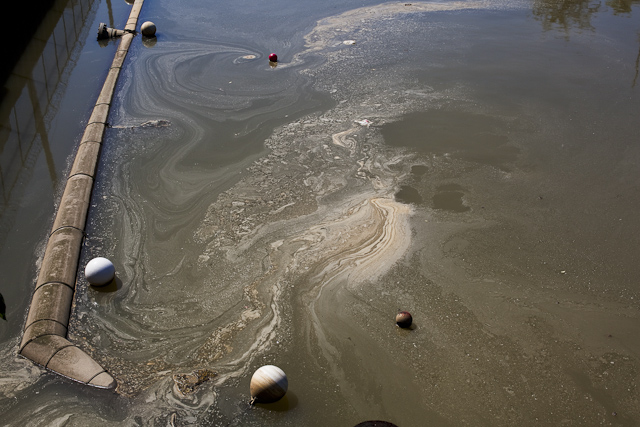
Germs linger even after the stench of sewage has dispersed. Healthy adults may never realize that yesterday’s swim caused today’s cough, diarrhea, or ear infection. Young children, their grandparents, and people already weakened by illness are more likely to become seriously ill or die. Scientists believe as many as 3.5 million Americans get sick each year after swimming, boating, fishing, or otherwise touching water they thought was safe.
A 1998 study published in the International Journal of Epidemiology blamed water pollution for one-third of all reported gastroenteritis cases and two-thirds of all ear infections. It’s not just the people who play in and around the water who are at risk. Between 1985 and 2000, the Centers for Disease Control (CDC) documented 251 separate disease outbreaks and nearly half a million cases of waterborne illness from polluted drinking water in the United States. Another study by the CDC and the National Academy of Sciences concluded that most illnesses caused by eating tainted seafood have human sewage as the root cause.
Outdated treatment plants

To understand why this is happening, it’s helpful to know some history. For centuries most American sewage poured into the nearest river or creek with little or no treatment, and few people gave it a second thought.
That changed when Congress passed the Clean Water Act in 1972 and the federal government began making significant investments to modernize sewage treatment infrastructure serving communities across the country.
Today, many of the plants built with that initial investment are undersized or are near the end of their effective lives.
There are 600,000 miles of sewer pipes across the country and the average age is 33 years. Some pipes in cities along the eastern seaboard are nearly 200 years old. Some are even made of wood. The American Society of Civil Engineers has given America’s wastewater infrastructure a “D” grade overall.
Runaway development
Today, poorly planned development compounds the problem of aging infrastructure. As urban areas sprawl into the countryside, new expanses of concrete and asphalt increase the amount of stormwater surging into sewers — and the amount of pollution spewing out.
[su_pullquote]A single acre of wetlands can hold up to 1.5 million gallons of rain or melting snow. Otherwise it winds up in the sewer system.[/su_pullquote] Trees help keep water out of sewer systems, too. In fact, the group American Forests estimates that as Washington, D.C.’s tree canopy thinned by 43 percent between 1973 and 1997, the amount of stormwater running into the city’s aging sewer system increased by 34 percent.
Older sewage systems combine stormwater with household sewage, but even in systems where they are separated some stormwater ends up in the sewer, where it contributes to raw sewage overflows.
All people deserve clean water free of the many dangerous pollutants found in sewage. The only way to ensure this is to stop sewage overflows and leaks and ensure that no sewage is released into our streams, rivers, and lakes untreated. It will cost hundreds of billions of dollars and take decades to update the nation’s wastewater infrastructure to this level.
But it isn’t enough to simply invest more. Protecting and expanding natural areas helps prevent stormwater from rushing into the sewer in the first place — stopping sewer overflows before they start.

That’s investing smarter.
In fact, planting trees, restoring wetlands, and creating green roofs are often the most cost-effective ways to expand the capacity of sewer systems.
A single mature tree with a thirty-foot crown can keep 4,600 gallons of water out of the sewer each year. For less than $300,000, it’s possible to construct an artificial wetland that can intercept 3.25 million gallons of stormwater otherwise destined for the sewer.
In June 2003, Ford Motor Company planted ten acres of vegetation on the roof of its Dearborn, MI truck factory, keeping as many as four million gallons of rain out of the sewer system each year. Projects like these prevent sewage overflows as surely as bigger pipes — and cost less.
Until we make significant progress towards reducing sewage in our water , there must be strong notification programs that will alert people when there is a danger of contacting raw sewage. Wastewater facilities should be required to notify the media, citizens, and environmental agencies when they release untreated sewage into the environment. American Rivers works for federal and state right-to-know policies that require citizens to be informed of sewage contamination in their waterways. Not only will such programs keep people healthy by avoiding raw sewage, but it will also galvanize further support for solutions to reduce sewage pollution.
Clean water. It’s essential. It’s irreplaceable. If Americans today want our children and grandchildren to splash along the shore at sunset or drink from the faucet without worry, then it’s time for us to act. It’s time to make the commitment to keep raw sewage out of our water.

Pollution Problem: Sewage Spills in San Jose Presentation
Introduction, the challenge, the solutions are expected to, sewer monitoring, purifying sewage water.
- Garbage and human waste is pouring into rivers and creeks are creating a pollution problem in the South Bay.
- All the polluted water from sewers flows through the creeks ends up in the Bay and carries whatever trash, debris and contaminants. Humans are exposed to untreated sewage through drinking contaminated water, water recreational activities, and/or ingesting contaminated fish. (Loosli et al., 2019, p. 769).
This study highlights the issue of controlling and cleaning of the pollutions in sewage.
Water is a crucial element for all known forms of life to be able to live. Groundwater quality and availability are essential for human consumption and social and economic activities. Most of the county’s portable drinking water comes from groundwater wells, reservoirs, streams, rivers, and lakes. Unfortunately, the impact of sewage on the environment is mostly negative. Treating sewage is a big environmental priority in every country because untreated sewage water can spill into rivers, lakes and seas, causing major pollution. Such dangerous chemicals as, for example, detergent chemicals, that are contained in sewage water, are dangerous not only for the natural habitat, but for humans as well since they consume this water. Unfortunately, sanitary sewer overflows are a common problem across the United States. All the water flows through the creeks ends up in the Bay and carries whatever trash, debris and contaminants. San Jose is a troubled spot for trash pollution and bacterial pollution that are spilled into the bay. Humans are exposed to untreated sewage through drinking contaminated water, water recreational activities, and/or ingesting contaminated fish. (Loosli et al., 2019, p. 769).
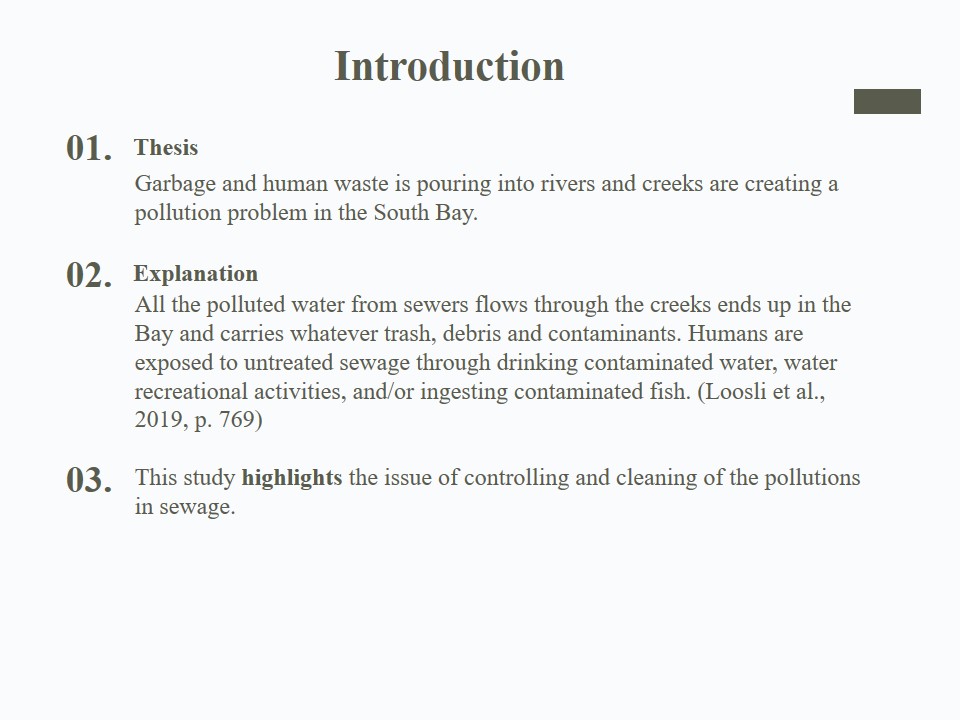
- Quick urbanization has enhanced the spills of of polluted sewage sludge in San Jose over the last few years.
- San Jose has more than 2,100 miles of sewage pipes.
- Considering that the sewage sludge contains toxic chemicals like nitrogen-containing compounds, organic matters and heavy metals, appropriate filtration and disposal should be utilized to prevent spills and following environmental problems (Lv et al., 2018).
- The new technology is expected to really improve the current inspection methodology by reducing the health risks for workers and making it affordable to public administrations, and also by reducing the pollution in sewage that can affect urban coastal areas.
Wastewater overflows (WWOs) are defined as a major public health issue, especially when there is a high possibility for citizens to come into direct contact with wastewater that has spilled into recreational water environments such as rivers, lakes, seas and oceans that are used for mainly recreational activities such as swimming. Infiltrated water from sewages can contain a number of pathogenic microorganisms including poisonous bacteria and viruses. Moreover, wastewater overflows have a significant effect on ecological situation of the region, creating a toxic environment for animals.

- Improve sewer workers health and safety measures
- Improve the public service given since it optimizes the sewer cleaning resources;
- Improve the quality of life of citizens since it will improve the sewer performance.
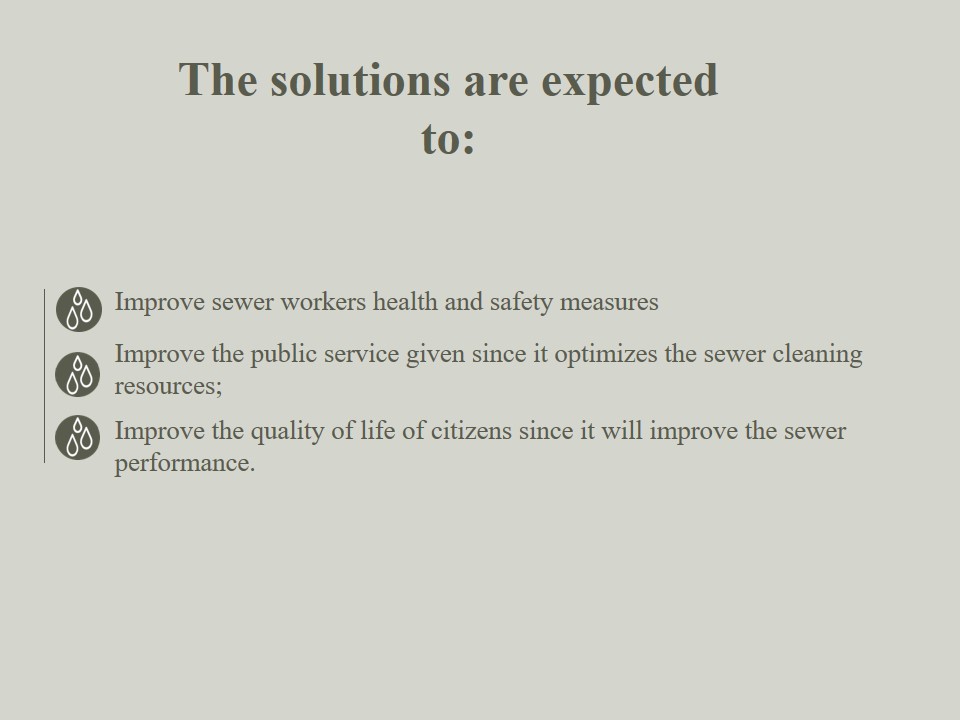
The goal of sewer monitoring is to develop the robot to the highest possible level of sensitivity which will let the sewer manager to manage the sewer efficiently without the need to move closer to dangerous and poisonous locations (Grau et al., 2017).
Among other reasons, robotized sewer monitoring is extremely useful:
- To keep the monitoring staff from going to sewers when there is a risky situation.
- To decide safety and health measures for staff.
- To track down any spills or leaks, which are usually unexpected and illegal,
- To make sure that sewer infrastructures are safe from abrasion, rust and aggressive spills.
- To define any patterns in sewage compounds (seasonal, daily, etc.).
- To use as an instrument for ecological investigations in sewers (David and Tobin, 2017, p. 172).
- Possibility to collect real-time data.
- Determining whether the system is consistently operating in free-flow conditions is easier.
- The information available from a flow-monitoring program saves collection system operators many times the cost of the flow monitoring.
- This method can be used in environmental research..
- The safety of staff is ensured as it does not require workers to go directly to sewage themselves.
- Lack of having a set of standardization develops problems with future integration.
- It will take some time to implement the robotic solution into the working routine of the staff.
- The development of the equipment demands high financial spending.
- This method provides the means of controlling, but not preventing unexpected spills.
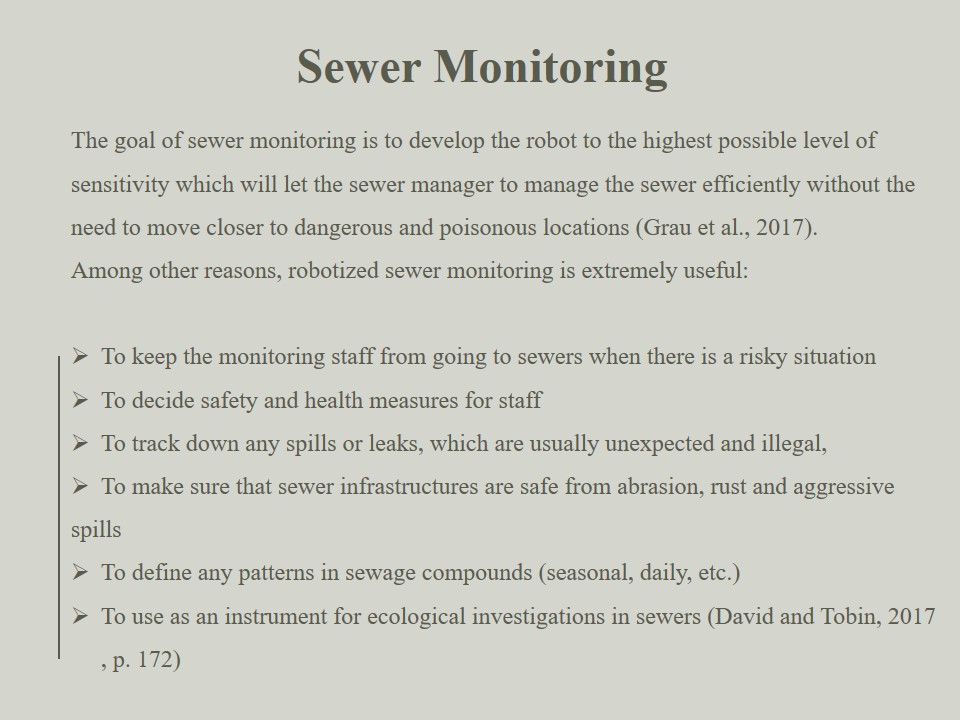
This method of purifying water is complex, but effective. Every day, approximately 100 million gallons of raw sewage is treated by the Clark County Water Reclamation District (CCWRD), with roughly 90 million gallons of reclaimed water released daily into the Las Vegas Wash (Nguyen, 2019, p. 24).
The stages of purification process :
- Water from homes and businesses is flushed and streamed to nearby treatment facilities.
- Sludge is removed.
- Trash is trapper by using a mechanical rake.
- The primary treatment using rotating metal arms to skim surface scum into troughs.
- Toxic chemicals are removed through aeration process.
- Water is filtrated through sand.
- Energy consumption is reduced.
- Purified and filtrated water does not contain toxins.
- With clean water the habitat of South Bay is protected.
- Reclaimed water for industrial, commercial, and landscape irrigation requires less treatment than recycled water for drinking.
- Overall environmental impact is reduced.
- The complexity of such method.
- Increased need for additional facilities and pipes to transport water.
- High financial costs for the equipment.
- Some regions still lack water recycling piping, that is why the implementing of the purifying equipment will be time-consuming.
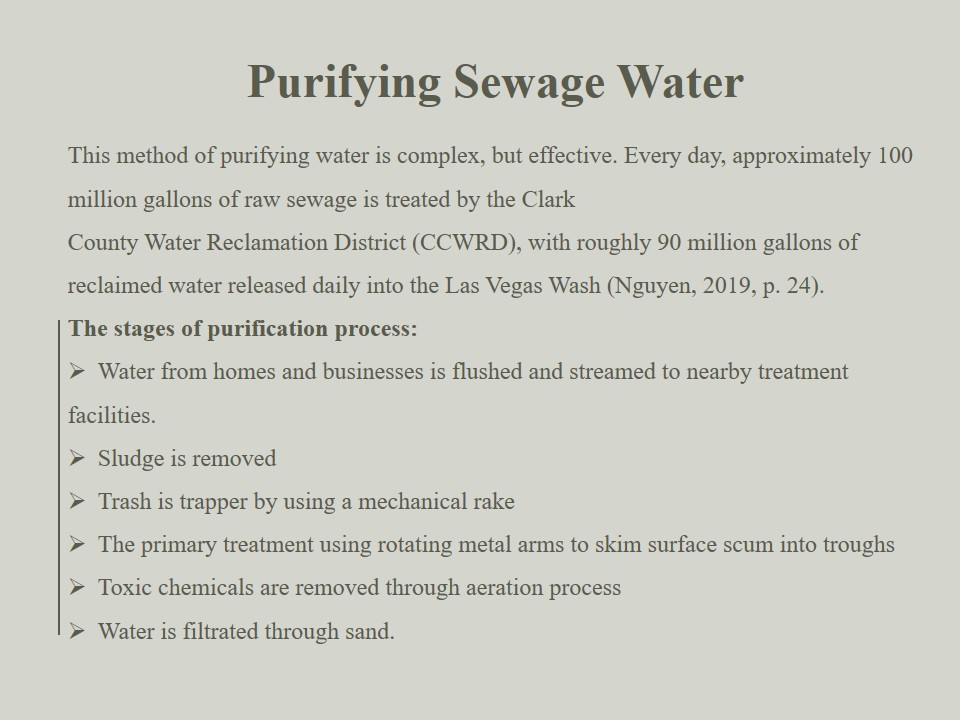
In recent years the problem of water sewage spills in San Jose has become more evident. The environmentalists are still trying to find efficient and low-cost solutions to the issue.
This presentation demonstrated two effective ways to control and prevent polluted water from spilling into South Bay.
Both methods that are described above have their own advantages and disadvantages.
Moreover, both methods have more benefits than costs. Nevertheless, purifying sewage water seems like a more appropriate solution since it provides quick positive results. That is why this solution is more efficient in managing sewage water as it prevents toxic spills from the start.
In conclusion it would appear that in order to maximize innovation, it’s compulsory to understand the significance of those innovations while breaking barriers in effective water management. In this case the risk of polluted spills will be greatly lowered.
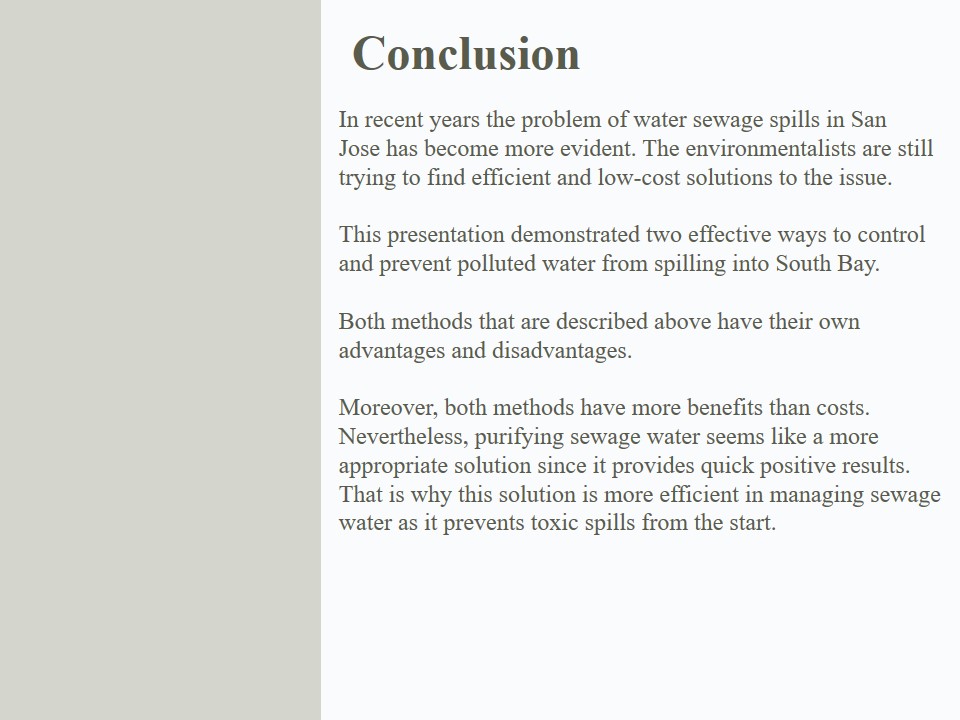
Grau, A., Bolea, Y., Puig-Pey, A., & Sanfeliu, A. (2017). Robotic solutions for sewage systems in coastal urban environments. Proceedings of OCEANS 2017-Aberdeen, pp. 1-5.
David, R. B., & Tobin, G. A. (2017). Understanding water policy sustainability: A case study in San Francisco and San Jose California. Environmental Science & Policy, 78 , pp. 167-172.
Loosli, F., Wang, J., Rothenberg, S., Bizimis, M., Winkler, C., Borovinskaya, O., & Baalousha, M. (2019). Sewage spills are a major source of titanium dioxide engineered (nano)-particle release into the environment. Environmental Science: Nano, 6(3), pp . 763-777.
Lv, D., Zhu, T., Liu, R., Li, X., Zhao, Y., Sun, Y., & Zhao, Q. (2018). Effects of co-processing sewage sludge in the cement kiln on PAHs, heavy metals emissions and the surrounding environment. International Journal of Environmental Research and Public H ealth , 15(4), p. 698.
Nguyen, S. (2019). The South Bay water recycling program: an evaluation of water recycling outcomes in comparison to selected cities and countries. San Jose State University, Master’s Project.
- Chicago (A-D)
- Chicago (N-B)
IvyPanda. (2024, April 27). Pollution Problem: Sewage Spills in San Jose. https://ivypanda.com/essays/pollution-problem-sewage-spills-in-san-jose/
"Pollution Problem: Sewage Spills in San Jose." IvyPanda , 27 Apr. 2024, ivypanda.com/essays/pollution-problem-sewage-spills-in-san-jose/.
IvyPanda . (2024) 'Pollution Problem: Sewage Spills in San Jose'. 27 April.
IvyPanda . 2024. "Pollution Problem: Sewage Spills in San Jose." April 27, 2024. https://ivypanda.com/essays/pollution-problem-sewage-spills-in-san-jose/.
1. IvyPanda . "Pollution Problem: Sewage Spills in San Jose." April 27, 2024. https://ivypanda.com/essays/pollution-problem-sewage-spills-in-san-jose/.
Bibliography
IvyPanda . "Pollution Problem: Sewage Spills in San Jose." April 27, 2024. https://ivypanda.com/essays/pollution-problem-sewage-spills-in-san-jose/.
- Wastewater Management Program for Abu Dhabi
- Water-Based Recreational Opportunities
- Ethical Issues in the Workplace: Gilbane Gold
- Biodegradable Study of PLA Packaging Application
- Non-Govermental Organizations in Environmental Changes
- Green Management and Environmental Auditing
- Agroforestry NGO Project
- Waste Collection in New York City
- Share full article
Advertisement
Supported by
Sewage Spill During the Blackout Exposed a Lingering City Problem
By Andrea Elliott
- Aug. 28, 2003
Minutes after New York City lost its power on Aug. 14, streams of raw sewage began to flow into surrounding waterways. By the time electricity was restored, 490 million gallons had spilled -- 145 million gallons from the city's largest pumping station, on the Lower East Side -- causing beaches to close and posing health and environmental hazards.
This was not the first time. The blackout of 1977 caused a sewage overflow of 828 million gallons, which spilled from eight treatment plants and the same sprawling station on the Lower East Side, the 13th Street Pump Station on Avenue D between East 12th and 13th Streets.
Back then, city officials found a solution: they provided all treatment plants with backup generators, which functioned properly, for the most part, during the blackout earlier this month. But no generator was ever built at the 13th Street Pump Station, a failure caused by a mixture of administrative lethargy and delays brought on by stiff community resistance.
So when the lights went out again, the sewage spilled out again.
''We always knew if there was a blackout, 13th Street would just shut its gates and pump everything out,'' said Alfonso R. Lopez, deputy commissioner for the Bureau of Waste Water Treatment. ''Everybody recognizes we need generators. No one wants to give up real estate.''
To be sure, this was not the only sewage problem on Aug. 14. More than 260 million gallons of raw sewage was spilled because of faulty or inoperable generators at 2 of the city's 14 waste water treatment plants -- Red Hook and North River. And even if those generators had been running properly and the 13th Street station had had backup power, sewage would still have spilled because of the lag time before generators begin operating, Mr. Lopez said.
But, city officials concede, it is a virtual certainty that the 2003 spill did not have to be as bad as it was. The proper functioning of the generators at North River and Red Hook would have made a huge difference. But that was not even a possibility at the 13th Street Pump Station, where a solution to fixing the problem is not nearly as straightforward and -- though under way -- is years in the future.
''It is outrageous,'' said Sarah J. Meyland, executive director of Citizens Campaign for the Environment, an environmental organization with offices around the state. ''Across the board there often is a very casual feeling about allowing raw sewage back into the environment under sporadic circumstances, as if sewage is really not that bad.
''In the same way we want the electrical system never to fail we should have the same expectation that the sewer system never fail except for acts of nature,'' Ms. Meyland added. ''Not a situation like this one where there clearly is an engineering solution available.''
The 13th Street Pump Station is surrounded by a low-income housing development and is across the street from a Con Edison plant, a combination that has produced a construction quagmire. Community leaders complained that pollution from the Con Edison plant, which is expanding, has added to already high asthma rates in the area.
For that reason, they have long resisted plans to build a diesel-fueled generator at the pump station, said Susan Stetzer, chairwoman of the public safety and sanitation committee for Community Board 3. ''You shouldn't be building it on the grounds of a housing development,'' Ms. Stetzer said. ''Why don't they build it on the grounds of Gracie Mansion?''
The argument that a power failure could occur seemed to hold little weight as the years passed.
''Over time it was easier to face the risk of sewer discharge than the reality of building a big plant in the face of community opposition,'' said Christopher Ward, commissioner of the Department of Environmental Protection. ''The environmental problem that sewage creates is invisible to New Yorkers, whereas taking property and diesel emissions is not.''
The city took little action toward building the generator until, in 1995, the state issued an order forcing the construction of two generators at the 13th Street Pump Station as part of a larger plan to upgrade a treatment plant in Greenpoint, Brooklyn. That plant receives 150 million gallons of sewage every day from the 13th Street station.
City officials attended meetings and gave presentations describing what the city felt it needed to do, but were met with anger and distrust from the people who lived nearby.
Still, the community board approved a plan in June to build the generators on the roof of the 13th Street Pump Station -- at a cost to the city of $9.75 million -- but the system will not be up and running for at least four years, Mr. Ward said.
City engineers can make positive comparisons when talking about the sewage that spilled this month. Before 1986, when one of the last of New York City's waste water treatment plants was completed, all of the sewage from the West Side of Manhattan spilled untreated into the Hudson.
City engineers also said that before September 1967, when the New Town Creek plant in Brooklyn was completed, more raw sewage spilled into the waterways every day than spilled during the blackout of 2003.
Still, the problems during the blackout underscored longstanding flaws with the way the city disposes of its sewage.
Propelled by gravity, waste water flows from sinks, toilets and showers to a maze of pipes below New York City's streets. These pipes also receive storm water runoff in most parts of the city. From there, the sewage is pumped to treatment plants.
New York is among 772 cities around the nation with combined sewer systems -- those that mix storm water with other waste. About 20,000 cities use a newer, more efficient system, separating the two forms of waste so that storm water is not processed at treatment plants along with sewage.
When it rains heavily, pipes in a combined system can overflow and spill raw sewage. In New York City, that happens about half the time it rains, causing an estimated 40 billion gallons of untreated waste water (20 percent of which is raw sewage) to spill into surrounding waterways every year, city officials said.
''Blackouts are unfortunate but are relatively rare,'' said Reed Super, senior lawyer of Riverkeeper, an environmental organization based in Garrison, N.Y. ''It really just points out a larger problem, which is that it happens on a regular basis. Raw sewage flows into our waterways every time it rains over a certain threshold.''
Along with other cities, New York City is trying to curb the problem of combined sewage overflows by building underground reservoirs that work almost like bladders. When waste water begins to overflow, some of it will be channeled to these three underground tanks. It will be held there until water levels drop again, and then the waste water will be pumped to treatment plants.
The projects, in Flushing and Alley Creek, Queens, and in Paerdegat Basin, Brooklyn, will cost more than $680 million. Critics say these efforts are a Band-Aid solution to a larger problem, and even city officials wonder how the city will keep up with the cost of maintaining the sewage system, parts of which date to the 1850's. ''The city faces billions of dollars of waste water upgrades,'' Mr. Ward said. ''A huge environmental question facing the city is the efficacy of those investments instead of competing environmental interests.''

IMAGES
VIDEO
COMMENTS
Sewage Spills is the Biggest Threat We are Facing in South Africa: An Argumentative Essay Guide: . The issue of sewage spills in South Africa has become a topic of growing concern in recent years, as the country continues to grapple with the negative consequences of these occurrences on public health, the environment, and the economy.
Public Interest Statement. This article addresses the worsening state of effluent, sewage and waste water mismanagement in South Africa. It identifies municipalities and government in general (and their indifference) as being the main contributors to water pollution in South Africa and highlights the state of waste water mismanagement as the cause hereof.
sewage overflows, occurring primarily during wet weather, spill into our recreational and drinking water, into groundwater, and directly onto private property, often in the form of basement backups.
26 Apr 2021 14. Billions of litres of poorly treated or untreated sewage, industrial and pharmaceutical wastewater are spewed into our rivers and oceans. By the government's own admission, 56% ...
The grisly matter of raw sewage entering natural water bodies was a massive ocean issue in the 1980s and 1990s until new laws were introduced, enforcing the treatment of wastewater before its release into the environment. ... Unfortunately, the answer is a resounding no as multiple wastewater spills occur in our oceans around the world every ...
X (Twitter) Across South Africa, sewage systems are leaking and contaminating the country's freshwater. Involving the affected communities can help prevent this pollution hazard, as a group of ...
Argumentative Essay About Sewage Spill. By Angelina August 27, 2023 October 6, 2023. The repercussions of sewage spills are far-reaching, affecting both the environment and human well-being. This essay delves into the detrimental effects of sewage spills and presents a compelling argument for enhanced preventive measures to mitigate their ...
Sewage is a danger to human health, but it also has a huge impact on the animals and plants living in waterways. For instance, algal blooms are encouraged by the presence of sewage and can lead to the deaths of many other species. Dr Anne Jungblut, Principal Researcher in algae, fungi and plants at the Museum, says algal blooms are 'a big ...
Two weeks ago, DM168 published an investigation looking into the dismal state of SA's sewage treatment works. Struck by the report's findings, we asked you, the reader, to suggest solutions.
Like many areas in South Africa, there are ongoing sewage spills into the Vaal River, predominantly from the Emfuleni Municipal wastewater treatment system, which have affected human and animal ...
Older sewage systems combine stormwater with household sewage, but even in systems where they are separated some stormwater ends up in the sewer, where it contributes to raw sewage overflows. Solutions. All people deserve clean water free of the many dangerous pollutants found in sewage. The only way to ensure this is to stop sewage overflows ...
water quality attributed to sewage spills from catchment based land activities (9). Spillage of untreated sewage also has adverse effects on the environment. For example, in 2008, there were media reports in KwaZulu Natal claiming that large amounts of sewage effluents were being discharged into the Durban harbour killing a large population of fish
1458 Words6 Pages. SEWAGE. Sewage is waste water, in solution or suspension, which contains some chemical and toxic substances, suspended solids and harmful bacteria. It consists mostly of greywater (from sinks, tubs, showers etc), blackwater (the water used to flush toilets, combined with the human waste that it flushes away) and soaps and ...
Request PDF | Impacts of a raw sewage spill on water and sediment quality in an urban estuary | A sewer main serving a large municipal wastewater system ruptured, discharging approximately ...
Make a claim. Provide the grounds (evidence) for the claim. Explain the warrant (how the grounds support the claim) Discuss possible rebuttals to the claim, identifying the limits of the argument and showing that you have considered alternative perspectives. The Toulmin model is a common approach in academic essays.
A sewage spill can be caused when wastewater treatment plants or pump-stations experience a mechanical fault such as loss of electrical power. Broken or blocked sewer mains can also cause sewage spills. Sewage may enter the waterway directly from the point of rupture or overflow, or through stormwater drains.
Thesis: Garbage and human waste is pouring into rivers and creeks are creating a pollution problem in the South Bay. Explanation: All the polluted water from sewers flows through the creeks ends up in the Bay and carries whatever trash, debris and contaminants. Humans are exposed to untreated sewage through drinking contaminated water, water ...
When it rains heavily, pipes in a combined system can overflow and spill raw sewage. In New York City, that happens about half the time it rains, causing an estimated 40 billion gallons of ...
Argumentative Essay On Water Pollution. Improved Essays. 820 Words; 4 Pages; Open Document. Essay Sample Check Writing Quality. ... 2011, p.101). The oil spill damaged over 1,300 square miles of coast line and caused the death of various sea life, including over 4,000 Alaskan sea otters (Seitel, 2012, p.101). Exxon Mobil's public relations ...
Published Oct 16, 2022. | Published Oct 16, 2022. Durban - The sewage spill from the faulty Blackburn pump station in uMhlanga that contaminates beaches is affecting the tourism industry in the ...
manhole or cleanout. If it is not contained within a short amount of time, this sewage will flow over land and may eventually enter a drainage system or a local stream or lake. A sewage spill is sometimes called a sanitary sewer overflow. Signs of a Sewer Spill . Sewage spills may be water gushing from a manhole or a slow leak. The sewage is ...
Picture: Nomonde Zondi. Durban — Street vendors trading outside King Edward VIII Hospital in Durban said the Department of Water and Sanitation's interventions on Wednesday on the sewage leak ...
Argumentative Essay On Oil Spills. 778 Words4 Pages. Oil: pitching people against each other and destroying Earth's habitat since the 19th century. It seems like the conversation on oil is never ending. Nations are constantly waging wars in order to possess the wealth that "black gold" brings. The devastation is inherent in the Middle ...